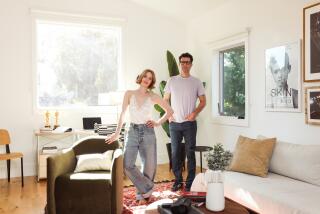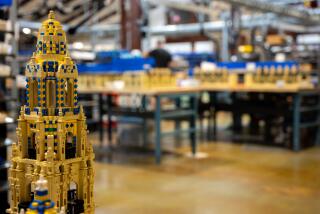Twin Talents
Southern California attracts talented people who want to help us create the interiors that we call home. Designing Minds, which debuts today, is an occasional look at the work--and the motivation--of these emerging artists.
*
While most children were playing sports or building model planes, Stefano and Christos Joannides discovered another way to amuse themselves: rearranging the furniture.
“Every Saturday I’d rotate the full house,” Stefano recalls, “without my mother knowing about it. But she loved it. Sometimes I’d go a little bit crazy, and she’d say, ‘What are you doing?’ I do it even now when I go back home.”
“I used to see him doing it,” recalls Chris, “and he’d say, ‘Can you please help me move this furniture?’ It was a popular pastime.”
Little wonder that these identical twin brothers chose to go into furniture design, architecture and interiors.
What is surprising is that the brothers are all of 26 and have a company called Idea Space Design, designing furniture, plus commercial and residential property and interiors. They have a gallery-studio space in Beverly Hills. And they’ve been in the United States only since 1992, when they moved from their home in Cyprus.
Their 2-year-old business has been housed in a small storefront on busy South Robertson Boulevard since August. On a recent sunny day the doors open onto the sidewalk, inviting the curious to investigate these contemporary maple pieces that are saved from rigid austerity by clean curves and classical lines.
There is the Divani, a bench suited for the foot of the bed, with hourglass arms and storage drawers. The Antis coffee table has an inset panel of sandblasted glass, and the Fontana has a sink embedded in a most unlikely table--true furniture for the bathroom.
Prices range from $350 for a lamp table to $750 for a writing desk to $3,500 for the Fontana; a lower-priced line includes lamp tables for $80 and a compressed wood and Formica dining room table for $750. All pieces are manufactured by a small company in San Bernardino.
“In design,” Stefano says, “people spend a lot of money, and interior design should be very simple, very basic, very healthy environments that will last for time.”
Adds Chris: “I believe that all the furniture you buy should transcend time to a certain extent. It can’t be too wild. And the contemporary pieces with straight lines, it gets tiring to the eye after a while. Give me a different line, something the eye can play with--this is where we try to avoid being completely contemporary.”
A Team Since the Day They Were Born
Although this is their first business venture together, Chris says, “We’ve been together ever since we were born. We used to be competitive swimmers when we were younger, and we served in the military together for two years. But we are the exact opposite. Stefano is more artistic, and I’m very direct, straightforward, very meticulous. Stef is always thinking ahead--’Let’s do this, let’s do that.’ And I’ll be saying, ‘Well, Stef, we need to do this first to get there.’ He’s been like that ever since I can remember.”
Their roles are clearly defined: Stefano designs furniture, draws up architectural plans and consults with clients on interiors. Chris concentrates on marketing, graphics and finding home decor pieces that complement his brother’s designs.
“I put the pattern together and paint the painting,” says Stefano, “and Chris does it in words and graphics, and it’s sort of two minds working as one. I cannot write if my life depended on it. But I’m visual, and I’ll just talk and tell Chris about how I want it to feel.”
This business partnership was never part of a grand plan. Both came to Southern California for college, the decision to go abroad prompted by their Harvard-educated father (Stefano studying architecture at the Southern California Institute of Architecture in Mar Vista, Chris majoring in journalism and art at Pepperdine in Malibu). Neither had set foot in the U.S. before, but the palm trees, warm weather and urban bustle were enough to prompt Chris to think, “I’m home,” when they landed at Los Angeles International Airport.
Stefano knew early on that his future was in design and architecture. One of his SCI-Arc professors, Los Angeles architect Norman Millar, recalls he “worked very hard, and not all students are willing to give that much of themselves. He was always persevering--things don’t come easily, and I don’t think he assumed they do.”
Meanwhile, Chris channeled his energy into writing.
“Chris is definitely creative,” recalls Ken Waters, assistant professor of communication at Pepperdine. “But I couldn’t picture him as a traditional working daily newspaper journalist. But writing was one of those creative expressions he wanted to explore. And the creative part of him was asking, ‘How do I fit in a journalism or communications career?’ We talked about New York, some of the architecture or interior design magazines he could work on.”
Chris admits that by graduation, he had had his fill of daily deadlines.
“I was toying with various ideas after graduating--I wanted to start my own clothing line, I wanted something creative. But then slowly Stefano started to get things together, and I was like, ‘Wow, this is pretty interesting.’ ”
Customers’ Taste Is Considered
Stefano hooked up with another designer after graduating, but the partnership was short-lived. The brothers’ current company includes chief financial officer Dale Monchamp and designer Abboud Malak. Early projects came through contacts; now it’s mostly word-of-mouth and off-the-street business.
“Stefano really understood what I liked, and he was working with my taste also, not just going off on his own, saying, ‘This is what you should do,’ ” says client Dr. Katherine Ahn. Stefano (then with his former partner) designed furniture and did the interiors of the Tustin Ranch home Ahn shares with her husband, Dr. Peter Nguyen.
Among Stefano’s pieces in their home are a bed and chest with inlaid wood, an entertainment unit, a coffee table and a dining room table.
“He asked us about entertaining,” Ahn says, “and although we don’t have any children now, we’re planning on having children, and he took that into consideration--so we don’t have to change all the furniture again. It’s nice--there’s a theme throughout the house.”
Current projects include a condo remodel, custom furniture for two South Bay apartments, and a reception area and office for a digital sound company.
The twins admit their age, even in youth-obsessed Los Angeles, is both a help and a hindrance.
Says Chris: “People think we’re young, we’re fresh, we’re energetic. And then there’s the other school of thought, that we’re young kids and let’s not take the chance.”
Having an avant-garde architect for a father was a huge influence for both siblings: “We always went to museums and galleries and art exhibitions,” Chris explains, “but we also used to go to his construction sites and walk through the rubble. We just soaked it up like a sponge.”
Stefano explains his interior design philosophy this way: “My favorite thing is to combine old pieces that mean something to the individual we’re designing for, with new. The memory, the sentimentality between an object, an image, and a person is priceless.
“Interior design should be more of an intellectual as well as a visual and conceptual thing. This isn’t about me saying, ‘I have an infatuation with blue, let’s paint the house blue.’ Keep everything basic, but what you have on the inside should be very, very meaningful and special to you.”
The Joannides brothers know they could have stayed in Cyprus and coasted in well-paid jobs in the family business. But that was never really an option.
“It was tough in the beginning,” Stefano says, “because we had expenses to open the shop, and we were getting an order a day or a week or a month. But I think having faith and just the passion and the loyalty I have to people, I had the ultimate dream that everything will be done in-house.”
They’ve thought about opening more gallery-studios in New York and London, but their hearts lie more in doing the work they love, not necessarily conquering the design world at any cost.
“You’ve got to have that passion and drive to keep going,” Stefano says. “It’s such a psychological way of living. Don’t have excess stuff. There’s no reason to have excess when people are starving, you know?”
“We could have had a very comfortable life in Cyprus,” Chris says. “But we have to do this. We get some support from our parents, but we want to make it on our own. This is the driving passion behind what we do. We’ve lived on tuna fish and pasta, but that’s made us appreciate the whole trip.”


